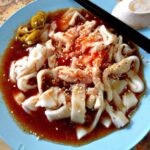Chee Cheong Fun: The Rice Noodle Dish that Showcases Malaysians' Creativity
Chee Cheong Fun 猪肠粉 also known as rice noodle rolls or CCF, is a specialty dish in Malaysia with roots tracing back to Chinese immigrants from Guangdong in the 19th century. This steamed delicacy made from rice flour sheets rolled into tubes has become a beloved Malaysian treat. Despite its name, which translates to “pig intestine rice noodles” in Cantonese, Chee Cheong Fun has evolved into something uniquely Malaysian, with a wide variety of sauces and toppings available across the country.
Originally a well-known Guangdong dish, Chee Cheong Fun quickly gained popularity when it arrived in Malaysia. Traditionally, it was served in dim sum restaurants with fillings like Char Siu (BBQ pork) or shrimp, accompanied by soy sauce. However, in Malaysia, Chee Cheong Fun has become a canvas for culinary creativity. Different regions have their own unique versions, with diverse ingredients and sauces that set them apart.
In Penang, Chee Cheong Fun is served with “hae ko,” a shrimp paste in the Hokkien dialect. In Ipoh, two main versions are popular: dry and wet. The dry version features bright red sweet sauce mixed with chili sauce and pickled green chili for added spiciness. The wet version is served with minced meat and mushroom gravy. In Klang Valley and Ipoh, the Hakka communities have influenced the dish, resulting in variations that include fish cake, fish balls, and curry sauce.
To make the basic Chee Cheong Fun rolls, a simple batter made from rice flour, tapioca starch, and water is mixed together. The batter is then steamed on a preheated baking tray, forming a thin sheet of rice noodle. Once steamed, the rice noodle sheet is carefully rolled into a tube shape and topped with the desired sauces and toppings.
While the steps to make Chee Cheong Fun appear simple, mastering the process is no easy feat. It requires years of practice to create these rice noodle rolls from scratch. Luckily, prepackaged fresh rice rolls are now available in Asian grocery stores, making it more convenient to enjoy this delightful dish. Simply steam the prepackaged rolls for a few minutes to soften them before serving.
Chee Cheong Fun can be found in Chinese restaurants, street stalls, and night markets across Malaysia. It is often served as a delicious side dish, complementing a wide array of other dishes.
Chee Cheong Fun has become a beloved Malaysian delight, offering a range of flavours and textures that cater to diverse tastes. From its humble origins to its creative adaptations, this dish showcases the culinary ingenuity of Malaysia. Whether you enjoy it with traditional fillings or explore regional variations, Chee Cheong Fun is a must-try for all food enthusiasts exploring the vibrant Malaysian food scene.




